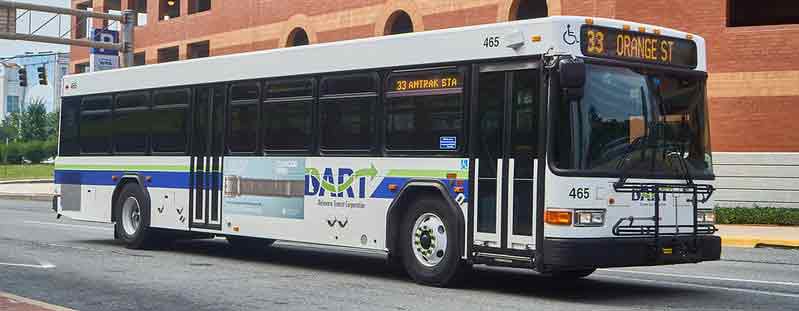
State officials are preparing bus alternatives as SEPTA rail cuts threaten Delaware commuters. (Photo by Jarrett Stewart)
Delaware transit officials are bracing for major service disruptions as SEPTA, the Southeastern Pennsylvania Transportation Authority, faces a $213 million funding shortfall that could gut commuter rail service between Philadelphia and northern Delaware.
At a July 1 informational webinar hosted by DART (Delaware Transit Corporation), state planners outlined proposed SEPTA service reductions and DART’s potential response—including a new bus bridge to Philadelphia—as they await action from Pennsylvania lawmakers.
Deep cuts coming in two phases
SEPTA’s proposed service cuts will roll out in two phases. The first phase, effective August 2025, includes reduced frequency across all Regional Rail lines, cutting service up to 20%, and specific reductions on the Wilmington/Newark line.
“The midday service would be reduced from hourly to operating every two hours, and there would be some peak and evening service to be eliminated. And one weekend trip would be eliminated,” said DART Deputy Chief Customer Experience Officer Kathy Smith.
Riders would also face a 21.5% fare increase.
Phase Two, effective January 2026, is even more severe.
“This would eliminate all service on the Wilmington/Newark rail line. So there would be no rail commuter service within Delaware,” Smith said.
According to SEPTA’s official methodology report, the second phase would eliminate five entire Regional Rail lines—including Wilmington/Newark, Chestnut Hill West, Cynwyd, Paoli/Thorndale, and Trenton—and close 63 stations, representing 44% of SEPTA’s regional rail mileage. All remaining rail and Metro service would end after 9 p.m.
RELATED STORY: Recent SEPTA cuts would shut down Wilmington/Newark line amid massive budget crisis
DART’s contingency: A bus bridge
To mitigate the impact on Delaware commuters, DART is developing a direct peak-hour bus service to Philadelphia from Newark, Wilmington, and Claymont stations.
“There would be a direct commute from the Newark station to 30th Street Station in downtown Philadelphia,” said DART Senior Planner David Dooley.
Fairplay Station is not currently included in the plan.
While exact timing is still in development, Smith said the service would generally mirror SEPTA’s peak train times: “It would be within the general time range.”
To inform the plan, DART will soon conduct a four-question survey at the three rail stations.
“We highly encourage you and your employees to take the survey,” Smith said, noting that ambassadors will be on-site during morning and evening rush hours.
Commuter reliance on SEPTA rail
SEPTA rail remains vital for many Delaware workers. A recent one-day sample showed that about 78% of riders travel from Delaware to Pennsylvania, and 22% reverse-commute into the state.
The busiest northbound Claymont train, departing at 7:09 a.m., carries 118 riders, while the 5:23 p.m. southbound return train brings back 102.
Despite recovering from pandemic-era lows, SEPTA ridership remains below 2019 levels.
“We still have not made it back to 2019,” Smith said.
Rail alternatives limited
While some asked whether DART could contract with another rail operator, officials explained it’s not feasible.
“Delaware does not have a rail division, so we don’t have conductors or engineers to run the actual trains,” Dooley said. “It’s much more complicated than running the bus service.”
Budget stalemate in Harrisburg threatens transit lifeline
As of mid-July, Pennsylvania remains more than two weeks past its June 30 budget deadline, and the funding outlook for SEPTA remains uncertain. While the Democratic-controlled House passed a $50.6 billion budget on July 14 (including transit funding), it did so without agreement from the Republican-led Senate.
This partisan divide means SEPTA still has no confirmed state support to close its $213 million budget gap. In response, the agency is moving forward with its “doomsday” budget: service reductions begin August 24, with even deeper cuts—including the elimination of all Delaware commuter rail service—slated for January 1, 2026.
Despite Pennsylvania Governor Josh Shapiro’s efforts to broker a deal, there is currently no timeline for Senate action, leaving the fate of SEPTA—and thousands of regional commuters—in limbo.
In the meantime, DART is preparing to roll out contingency plans such as a bus bridge to Philadelphia and conducting rider surveys at Newark, Wilmington, and Claymont stations to better understand community needs.
“Everything that we are considering will not be happening until January of 2026,” Shields said, “either in the form of a bus bridge or maybe some type of hybrid bus rail service.”
What’s Next?
DART encourages public participation in shaping future service. Public hearings on broader service changes will be held the week of September 15.

Claudia is a Philadelphia-based journalist and reporter passionate about storytelling that informs and engages the community. Claudia, a proud Temple University graduate, has built a career covering impactful stories and creating compelling content across digital and print media platforms. With a strong background in writing, editing, and research, Claudia has worked on various topics, from local news to in-depth features, always striving to deliver meaningful and accurate reporting editor@townsquarelive.com
Share this Post







